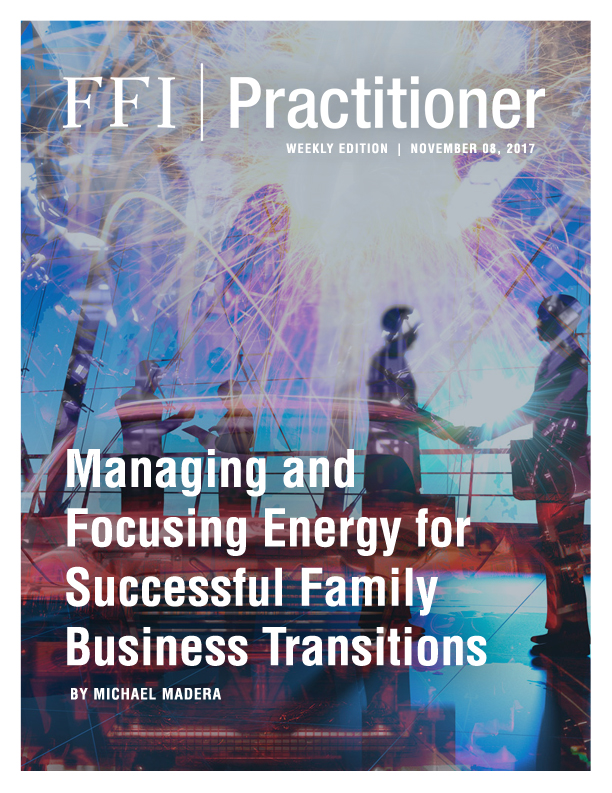Editions Viewable On Any Device.

From FFI Practitioner
This week’s FFI Practitioner Edition by Michael Madera categorizes the mindset of many family firms in the midst of transition into “Hold, Mix, and Shift.” Using one of his clients, a 70-year-old auto parts company, as a case, Madera shows us how to utilize this model to keep positive energy flowing towards healthy family dynamics and successful transition of the family legacy.
I recently had the opportunity to choose a new car for my family and, after doing way too many hours of internet research, I found that the choices boiled down to three options:
- Standard gasoline powered internal combustion engine
- Hybrid drive trains, combining gasoline and electric motors
- Electric motors and various sizes of batteries and driving ranges
As I considered the options for new vehicles, (email me to hear what I chose <grin>) I noticed that framing the choices in these three categories is quite similar to the options often available to family enterprises at moments of transition, both in ownership/succession and business strategy considerations – and could be labeled “Hold, Mix and Shift”:
“Over the years, I’ve noticed that the greatest risks to strategy decisions often involve emotional or family dynamics-driven considerations, such as denial, passive-aggressiveness, or biased judgment based on closely-held beliefs that are not carefully evaluated.”
As we practitioners know well, the largest risks to healthy energy flow in family enterprises usually occur during times of succession and transition in ownership and business strategy. This is when volatile, ungrounded and unpredictable dynamics often increase, sometimes leading people to choose to unplug or cut-off from some or all aspects of family or business life.
In my experience, these risks increase when families conflate the process of family succession and choice of business strategy. The trick is to address the concerns in each circuit independently; then look at the impact of options on the broader interdependent systems, seeking to balance energy flow and boundaries to support both family and business needs. This article will provide a model and tips for talking with and helping families ride the currents of change safely and productively.
For example, consider the options for a client of my firm, an auto parts company that pioneered a new method for building specialized parts in the 1950s and is now considering options as the 2nd generation owner prepares to retire, and two of his three children are working in the business. This firm has many opportunities to build on its 70 years of success, having a strong and stable core business in an industry that is also evolving rapidly. Here are some options available to them, framed in the Hold/Mix/Shift model:
Over the years, I’ve noticed that the greatest risks to strategy decisions often involve emotional or family dynamics-driven considerations, such as denial, passive-aggressiveness, or biased judgment based on closely-held beliefs that are not carefully evaluated. In this case, there is a strong tension between a Hold and Mix strategy between the 2G and 3G leaders that had simmered for years. The 2G leader and his father, the founder, had their initial success in parts for internal combustion engines and saw little reason to change.
The 3G leader, now in his late 30s, was highly motivated to push into new applications and electric motors to position the business for growth, as his own father had done decades before. The ‘Mix’ solution emerged for this family through the recent hiring of an external sales executive with a track record of success in negotiating deals for electric motor components. This move is providing a rigorous test for the 3G leaders’ strategy along with the introduction of business judgment that is more insulated from familial and personal dynamics.
As family enterprises consider addressing succession of controlling ownership, we can use the Hold/Mix/Shift model again to frame choices and risks.
“When working with families encountering succession challenges, I suggest working separately on both family and business issues using rigorous and systematic methods to increase awareness and skills, and then seek solutions that optimize strengths and minimize risks.”
Sidebar

Addiction, Advisors and Alliances: Working Together to Address Complex Family Issues
FFI Practitioner article
by Michael Madera
Even within the healthiest family systems, advisors to high net worth families have to balance competing agendas, challenging family dynamics and the preservation of wealth.
In addressing ownership transitions, conflicts usually emerge over the pace of change and adaptation in the business. Often the senior generation members are more risk averse and conservative in their approaches, while leaders in the incoming generation are eager to make changes to keep up with (their perception of) evolving conditions, and to begin to make their mark on the family enterprise. These situations are ripe for misunderstanding and difficulties since, again, the motivations of each generation are sometimes determined by family dynamics as much or more than careful analysis. In the case of the family with the auto parts company, the 2G owner has retained his title as CEO and his 95% ownership, even though he has been much less involved in the business due to recurring health problems. This ‘Hold’ type of situation leaves the incoming generation feeling in limbo and unsure how best to support the family and bring more active approaches to ownership responsibilities.
Recommendations
To adapt to evolutions in business and family systems, families need support to evaluate and change long-standing habits and relationship patterns. By analogy, old wiring in a house needs to be upgraded to handle demands for more power and to maintain good insulation to prevent short circuits and burn outs.
When working with families encountering succession challenges, I suggest working separately on both family and business issues using rigorous and systematic methods to increase awareness and skills, and then seek solutions that optimize strengths and minimize risks.
Family
Goal: increase awareness and analyze impact of patterns and tendencies in family system, then increase skills and build structures. These can help to make ‘wiring’ more robust and put ‘circuit breakers’ in place to avoid overloads and burn outs.
Increase awareness
- Use genogram creation and analysis to map out the patterns over generations to increase understanding and put current dynamics into perspective
- Assess and review personality styles and strengths of family members (using tools like MBTI or DISC),to increase individual self-awareness and provide shared language for addressing relationship patterns
- Assess and review styles of communication, decision-making and risk-taking of family members to increase self-awareness and to understand and talk about each other’s preferences
Increase skills
- Provide education and training in emotional intelligence and communications skills to build capacity to handle even highly charged interactions productively
Facilitate individual and group conversations to help family members talk about hopes and fears regarding change, to share concerns, normalize anxiety, and build towards improved communications when feeling stressed.
Put structures in place
- Establish and document agreements and policies starting with less contentious concerns to provide good boundaries and clear expectations of conduct and decision-making
- Facilitate and train family members in conducting well-structured meetings to increase confidence and provide regular and predictable venues for discussions
Train family members in identifying situations where emotions or conversations start to get too hot to handle, and provide coping strategies to reduce intensity or pause conversations to avoid explosive and damaging interactions.
Business
Goal: Decision processes are insulated from family dynamics and are well-informed to manage risks and exploit opportunities
- Help family members monitor and analyze conversations to identify how family dynamics may be influencing business considerations
- Perform dispassionate business analyses to increase awareness of options/risks using methods to drive rigor and logic into decision-making, e.g. tools like SWOT analyses and McKinsey 7S analysis
- Create or update formal Business Plan for the next 2-3 years, to continue to assess and address risk and to increase clarity and confidence in strategy going forward
Across Family & Business Systems
Goal: Integrate choices across systems & design opportunities for collaboration and cooperation
- Identify key strengths and talents of both the family and business systems
- Seek out opportunities to develop and expand on strengths, while identifying tendencies or interaction patterns that risk reducing effectiveness
- Conduct ‘what if?’ simulations to predict and develop coping strategies for situations where family dynamics tend to overly influence business or ownership decision making
Using these and other approaches, practitioners can help to keep the energy flowing to support the greater good of healthy family dynamics and to ensure the passing on of a positive legacy.

About the contributor
Michael Madera, ACFBA, is a consulting psychologist and executive coach with 18 years’ experience in the areas of individual development and organizational consulting. As an entrepreneur, he managed two food products companies before seeking his psychology degree. Michael can be reached at michael.madera@maderapartners.com.
About Madera Partners Consulting
Madera Partners Consulting was founded in Acton, MA in 2003 with the goal of partnering with clients to support their growth and prosperity. Originally focused on assessment and development of managers and executives, the mission of the firm has grown to be more responsive to clients’ needs for processes to develop innovative strategies and continuously align people with these strategies.
Related Articles
If you enjoyed this article, view the related articles that also address succession and transition in ownership and business strategy.







